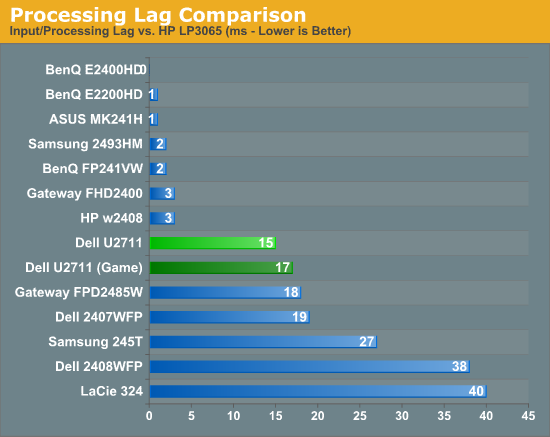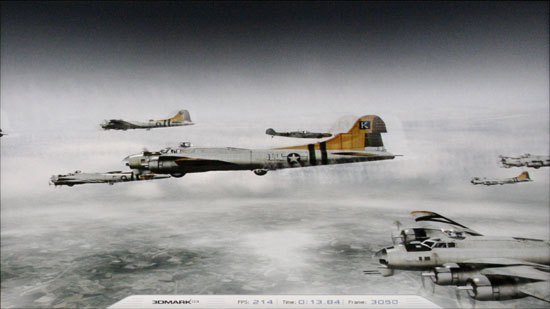Dell UltraSharp U2711: Quality has a Price
by Jarred Walton on January 22, 2010 2:00 AM EST- Posted in
- Displays
Dell U2711 Lag and Response Time
Some users are very concerned with display lag and pixel response time. For others, they really don't notice anything unless a particular display is very sluggish. I fall into the latter camp, though I do notice the processing lag when it's above ~40ms (e.g. on the Dell 2408WFP and LaCie 324, my mouse input just felt off.) To test for display lag, we run the Wings of Fury benchmark in 3DMark03, with the output set to the native LCD resolution - in this case 2560x1440. We clone the output to our reference LCD, an HP LP3065, snap a bunch of pictures, toss out any where the time readout isn't clear, and then average the remaining results (at least 10, and usually 20 or more).
As a reminder, the reference HP LP3065 is one of the best LCDs we currently possess in terms of not having display lag. (The lack of a built-in scaler probably has something to do with this.) While we know some of you would like us to compare performance to a CRT, few users have CRTs these days and all we're really interested in measuring is the relative lag. It's possible we will find an LCD that ends up with a negative result, meaning it's faster than the LP3065, but the best we have managed so far is a tie.

So far, all of the S-PVA panels we have tested show a significant amount of input lag, ranging from 18ms up to 40ms. In contrast, the TN and S-IPS panels show little to no processing lag (relative to the HP LP3065). The BenQ FP241VW with an S-MVA panel performs similarly to the TN and IPS panels, with an average display lag of 2ms - not something you would actually notice compared to other LCDs. What about the new U2711?
We tested with the "Graphics" setting and Adobe RGB as well as "Video" and "Game" - we figured the latter might disable some post-processing and result in less lag. That turned out to be incorrect, as our measured lag actually went up 2ms. However, in practice the settings are pretty much tied. That means the U2711 has around one frame of lag relative to our best LCDs, but it still has a lot less lag than our worst offenders. As stated already, I didn't notice lag in using the U2711 - just like I didn't notice lag on the 2407WFP or the FPD2485W. I did notice slight lag on the Samsung 245T and some clear lag on the 2408WFP and LaCie 324, but the threshold for lag varies and you'll need to determine if 15-17ms is too much or not for you. If you've tried any TN panels and still noticed lag, we would expect every current LCD to be above your "lag threshold".
 |
Despite what the manufacturers might advertise as their average pixel response time, we have found most of the LCDs are basically equal in this area - they all show roughly a one frame "lag", which equates to a response time of around 16ms. Some transitions are faster than others, but the above is representative of what we found in a study of numerous photos. If you look at the tail of the center plane, you can see a slight ghost image before and after the dominant frame. Some of that will come from the camera (we use a 1/120s shutter speed), but most of it comes from the LCD panel. In this case, the U2711 panel does outperform most LCDs that we've tested, where it was often possible to see at least three frames more clearly than the two slight ghosts in the above image.










153 Comments
View All Comments
dszc - Tuesday, March 2, 2010 - link
Jarred,Thank you for such great display reviews. I am an avid fan and have found no others as good.
I have 2 questions/requests:
1)Would you please do a review comparing good quality LCD and Plasma TVs to a "computer monitor" like the HP 3065.
I am a pro photographer and spend most of my days processing images. I find it easiest to see artifacts and other processing problems on displays with bigger pixel pitches (like my Dad's 1080p 58" Panasonic Plasma). I guess I'm saying that I want to see my images at their worst, but accurately.
I'm about to pull the trigger and move to a 35-45" LCD or Plasma TV as my prime editing monitor, but I'd like to see how they stack up in one of your top-notch reviews.
2)Where can I get Monaco XR software. I have the DTP 94 colorimeter, but I need the software. I have used ColorEyes form many years, but have never been happy with it. And now I can't even get it installed on Windows 7.
Thanks for any help you can give me. And keep those great display reviews coming!
EnzoFX - Wednesday, February 17, 2010 - link
Looking for a big screen, how do the 30 inch monitors from Dell compare? I wish there was a nice big chart with several of the monitors in this range.Would like to see how the u2410, 3007wfp, 3007wfp-hc, and 3008wfp compare with the reference HP 30" in processing lag.
pjackson11 - Monday, February 8, 2010 - link
Here's another review with calibration reports and such: http://www.flatpanelshd.com/review.php?subaction=s...">http://www.flatpanelshd.com/review.php?subaction=s...kasakka - Wednesday, January 27, 2010 - link
The lag when turning on and switching resolutions is really annoying on the 3008WFP. I switch between my Macbook Pro and my desktop PC and the lag annoys me. Otherwise I haven't noticed any real input lag problems with the display.I was hoping that Dell had fixed that problem for the newer models but apparently they just crammed the same software and hardware in with a smaller panel.
mikeyakame - Wednesday, January 27, 2010 - link
I find the turning on lag to be the worst personally. Resolution switching lag isn't nearly as bad compared to that! Other than that there is no real input lag you are definitely right there. It behaves really well at native resolution on DVI-D.ochentay4 - Tuesday, January 26, 2010 - link
Hi, how can I calibrate my crappy Dell S2409W without professional tools? Is there any way?mikeyakame - Wednesday, January 27, 2010 - link
You could pick up one of these for personal use, they aren't all that expensive and the result is pretty good for the price.http://www.pantone.com/pages/products/product.aspx...">http://www.pantone.com/pages/products/product.aspx...
I've got a Huey Pro myself, this model:
http://www.pantone.com/pages/products/product.aspx...">http://www.pantone.com/pages/products/product.aspx...
And the main difference is the software mostly, a few extra features on the Pro software, like being able to set gamma and cool/neutral/warm color temps through the tray tool.
The results I've got with my Dell 3008WFP with the Huey Pro are quite good, while it doesn't detect reds all that perfectly, I don't mind the slight red tint, it makes it alot easier to sit 30cm away from the monitor and have it not hurt my eyes.
Food for thought anyway.
ochentay4 - Wednesday, January 27, 2010 - link
Thanks man. I also read that AVIA Guide to Home Theater and Digital Video Essetials are very good DVDs to calibrate for videos. I supose that the calibration is worse than PANTONE products. I will test and see. Shame I really dont have money right now.jazzfreek - Monday, January 25, 2010 - link
Very nice article. I enjoyed reading it as I am in the market for something like this. One thing that caught my eye was your comment regarding better results using Monaco Optix over Coloreyes Display Pro and remembered seeing Integrated Color recommending using the Spyder 3 calibration puck over the otherwise recommended DTP-94 when calibrating wide gamut displays. I believe the DTP-94 is the same colorimeter as the one you use. Perhaps the older puck isn't sensitive enough to the new wide gamut. (see link). Thought you might be interested in this. Thanks.http://www.integrated-color.com/mm5/merchant.mvc?S...">http://www.integrated-color.com/mm5/mer...&Cat...
10e - Tuesday, January 26, 2010 - link
The Spyder3 is deficient in measuring black levels and color gamut, so I wouldn't recommend it. The Eye One D2 and DTP-94 are both better at this.